Article's Content
What Is An SEO Driven Comparison Page?
An SEO-driven comparison page is a specialized type of content designed to rank highly in search engine results for keywords associated with comparing two or more products, services, or entities. The primary goal of such a page is to provide users with a detailed, unbiased comparison that aids them in making informed decisions while simultaneously optimizing the content with relevant keywords, meta tags, and structured data to enhance visibility and drive organic traffic from search engines.
These pages are crafted to balance informative and persuasive language, integrating user-friendly layouts with tables, bullet points, and headings that make comparisons easy to understand at a glance. Additionally, an effective SEO-driven comparison page not only compares features and benefits but also addresses potential drawbacks, pricing differences, user reviews, and any other information valuable to the reader’s decision-making process. Through strategic keyword placement and high-quality content creation, these pages aim to answer the specific queries posed by users conducting comparative research online.
How Can SEO Driven Comparison Pages Lead To ROI?
SaaS is competitive and every brand is pushing for attention and market share.
SEO-driven comparison pages emerge as a powerful tool to not only attract but also educate potential customers. By leveraging these pages, brands can strategically position themselves against competitors, highlighting unique features and advantages directly in search engine results. This not only improves visibility but also targets users conducting pre-purchase research, providing them with valuable insights to make informed decisions.
Furthermore, SEO optimization ensures that the comparison content reaches its intended audience by matching specific search queries, thereby increasing organic traffic and improving conversion rates. In essence, well-crafted SEO-driven comparison pages serve as an invaluable asset for SaaS brands aiming to stand out in a crowded market by offering clarity, value, and insight right from the search engine results page (SERP).
An Example Of Comparison Pages Done Right: Matterport
Matterport started out as a maker of 3D cameras and is now a subscription software company helping institutions, organizations and people turn real life properties into digital experiences.
Have you ever bought a new home or looked for an apartment online? If you have ever seen the 3D experience in the real estate listing where you can view the different rooms in the property as if you were actually there in person — You have experienced something like the final product of Matterport. In fact, it’s possible that the experience was actually powered by Matterport.
Today, Matterport generates $55.2M in annual revenue per year with 4.9 million spaces under management. The pandemic has certainly influenced the surge and success of their business and it will be interesting to watch how it grows in the years to come. However, something that they will need to overcome amidst all of this is one simple reality:
The competition is heating up.
These organizations have a massive total addressable market as they’re all competing to capture the interior of every building in the world. How massive? Well… There are more than 4 billion buildings in the world and thousands of new ones constructed every single day.
That’s a lot of opportunity.
And with all opportunity comes a plethora of people who want in on the action. This has resulted in a handful of startups and major corporations trying to capture this market.
Here’s a few existing brands in this space:
- Lidar
- Kuula
- Cupix
- iGuide
- 3DVista
- Metareal
- Zillow 3D
How did I learn that these brands were in this space? I simply went into Google and searched for “Matterport vs” and “Matterport or” to be met with this result:
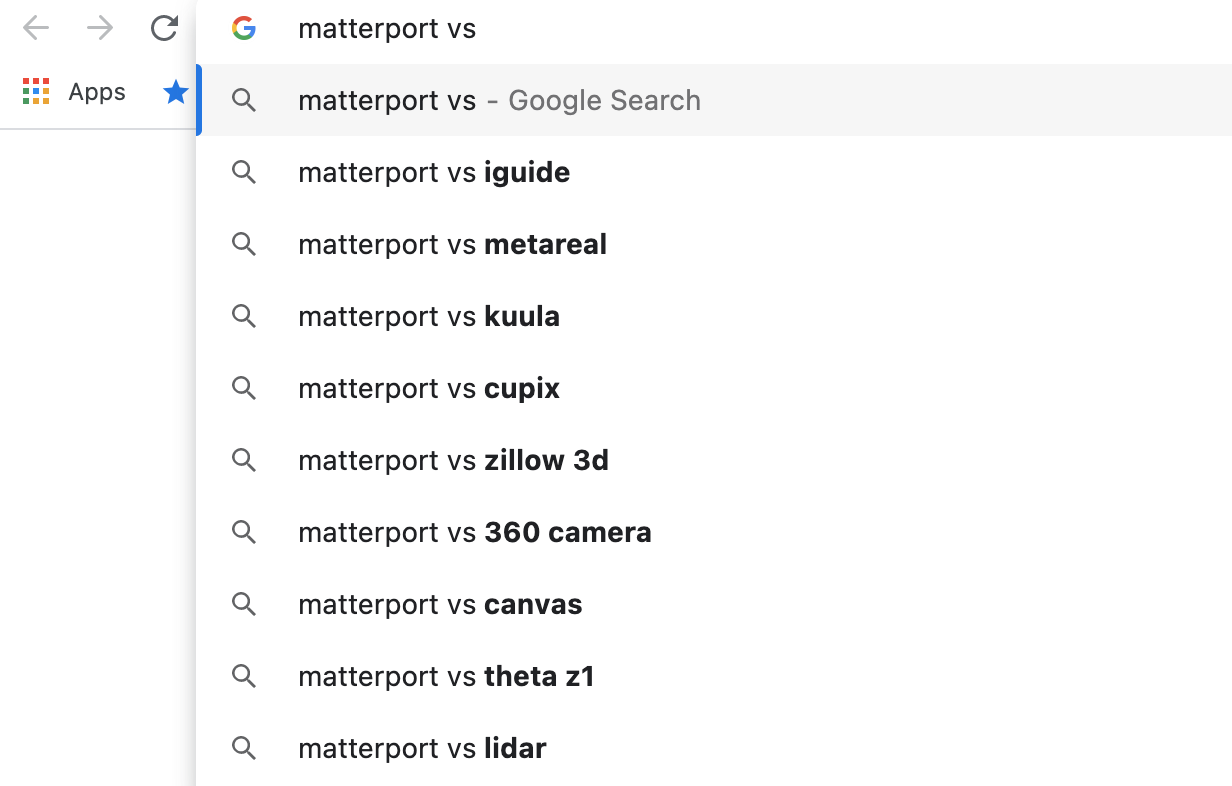
Every week people are going to Google and comparing Matterport with alternatives.
Annually, there are roughly 1,680 searches for Matterport vs Cupix and roughly 840 searches for Matterport vs iGuide. These are just two of the products that Matterport competes with. One could safely assume, on an annual basis, there are more than 5,000 people looking to compare Matterport and other alternatives based on these competitor keyword variations alone.
The estimated CPC for Google Ads against these keywords is relatively cheap ranging from 15 cents to $4.20. I say it’s relatively cheap because it’s safe to say that the people you’re reaching, when this type of search is being conducted, are individuals who are already in the decision making process. Meaning… A decent portion of this audience would likely convert into a sale as it’s safe to assume that this type of search would be conducted by someone with the intent to shop (discover / learn) or the intent to buy (convert).
Companies like iGuide have realized this. They are running ads at variations of these keywords and have landing pages that speak to their audience’s questions around Matterport vs iGuide.
This is what the Matterport Alternative page looks like:
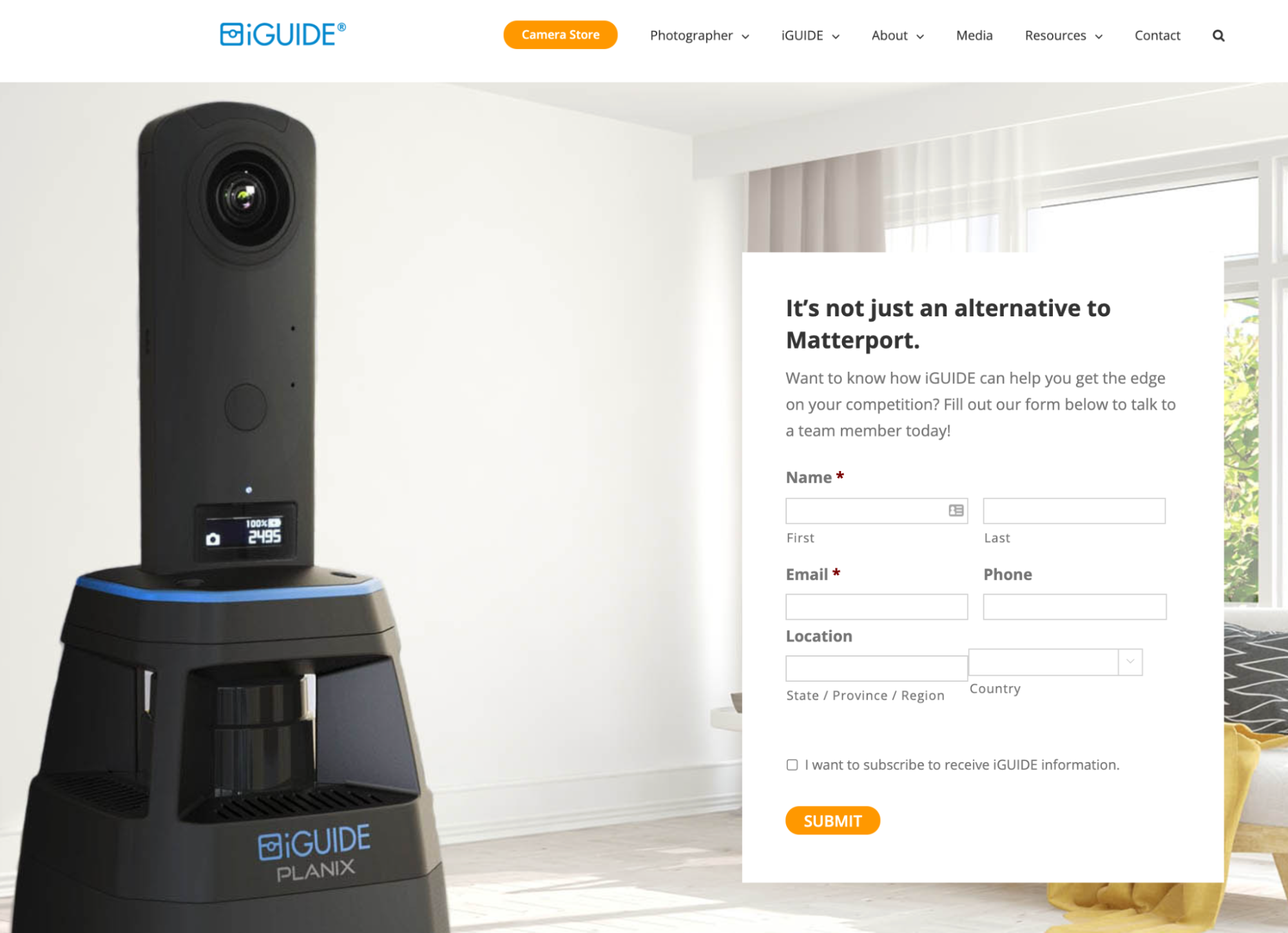
It’s definitely conversion driven.
There’s not much time being spent educating people on the differences – they want you to fill out their form and hear the differences directly from an iGuide sales representation.
If that form doesn’t sell you, the other option is to scroll down a bit further where you will be met with the traditional feature comparison matrix showcasing the benefits and weaknesses of each:
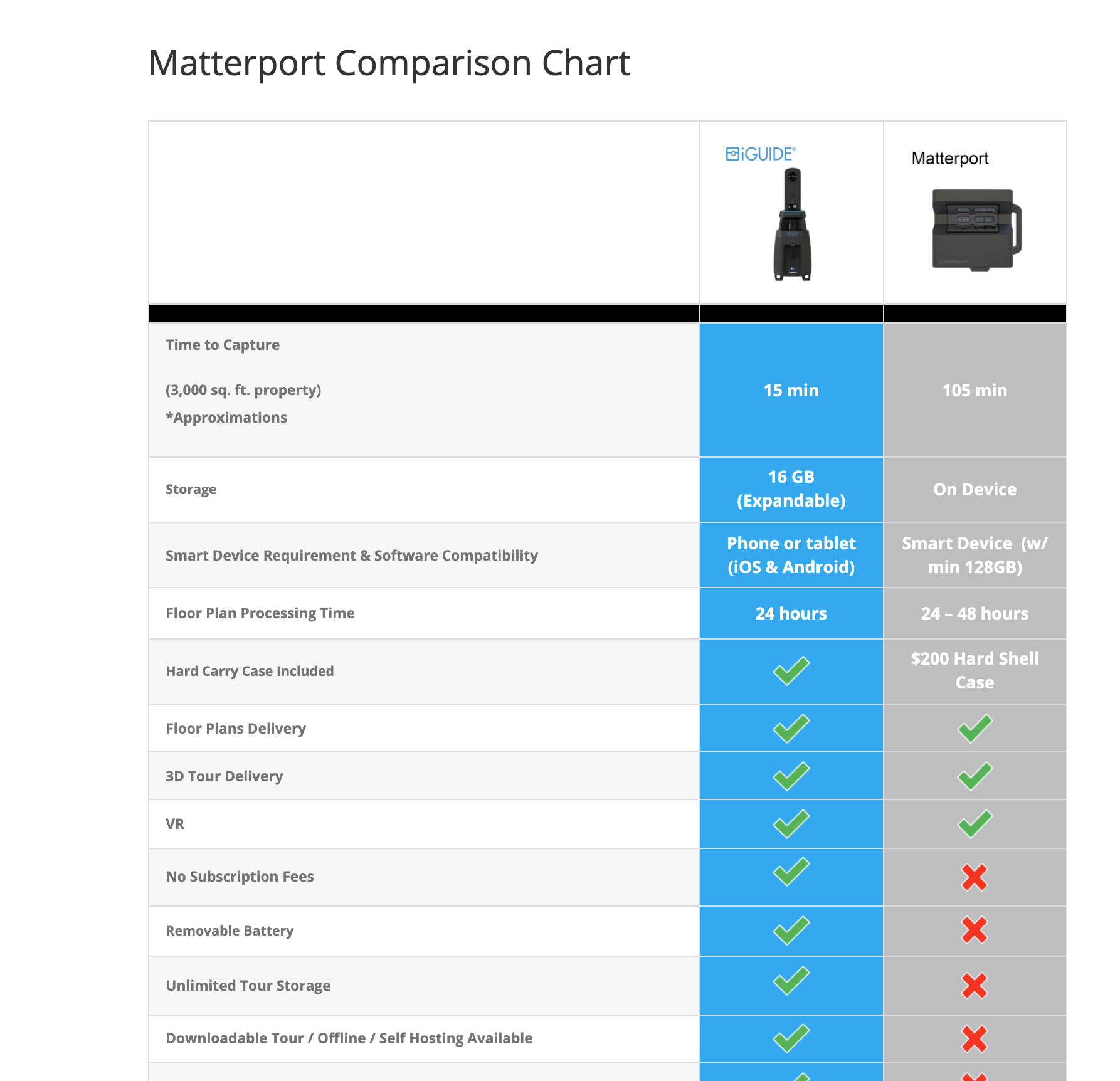
Something I’ve noticed about comparison charts is that these charts ALWAYS start by giving their competition a few green check marks before absolutely destroying them with red x’s. While I have no data to support this idea, I think the mutual / shared green check marks are psychologically meant to give reassurance to the reader that the brand isn’t biased and that they accept the fact that their competition does do some things well. But c’mon…
We all know (or at least marketers do) that you can sugarcoat and select the benefits you want to compete on as much as you want on the internet.
While these landing pages are a massive opportunity for brands competing. Another opportunity that brands often overlook is the fact that you don’t need to JUST go after these search terms using paid media efforts. You can also create landing pages that live on your primary site and begin to develop an organic strategy that puts you in the SERP without having to spend on ads.
Today, there are a TON of blog posts and landing pages that show up in Google for the phrase “Matterport Alternative”. This phrase is estimated to generate more than 15,000 searches per year and these websites are capturing a ton of that traffic.
Take a look at the SERP:
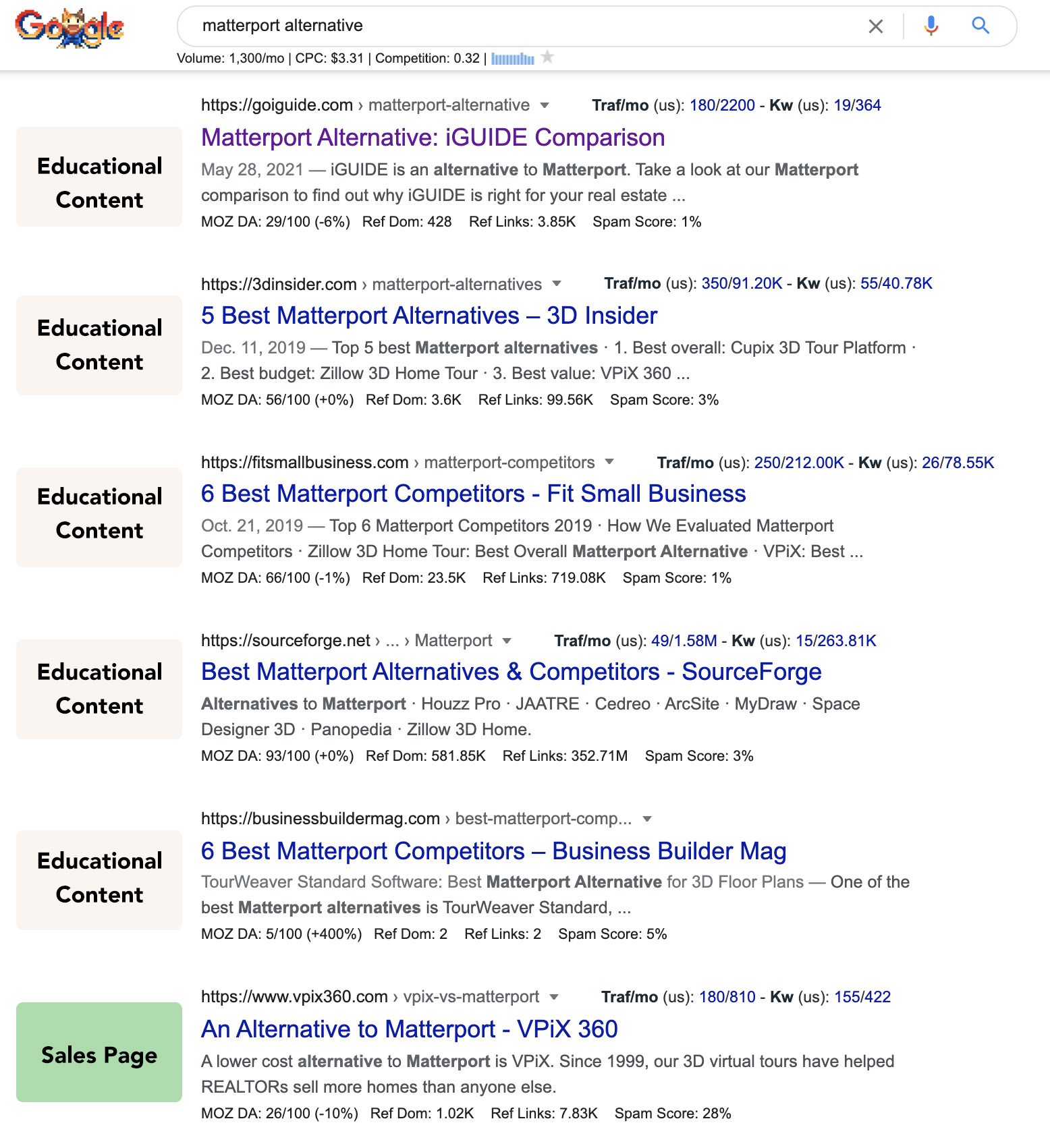
Five of the six results are educational assets. Landing pages created by sites that outline the pros and cons of different products with the intent of either (1) running ads against this traffic or (2) driving affiliate traffic to various websites so they can get a cut.
So what does this mean for you?
If you’re working at Matterport or any of their competitors — it means that you should be thinking about how you can create educational content that is better than what already exists. It means you might want to reverse engineer the success of that sales page and see why it ranks.
But here’s where things get even more complicated.
Directly above all of these links is something that blew my mind.
It’s a collection of YouTube videos within the Featured Snippet. The Featured Snippet is so sophisticated that it provides you with time stamps showing the alternative (Metareal) along with the moment in which the YouTuber describes the product. Check this out:

That’s right.
YouTube is ranking #1 in the SERP…
So while a bunch of content creators are patting themselves on the back for having their educational landing page rank # 1 in their SEO dashboard — the truth is — they’re not really.
This is why I’m a believer that YouTube SEO is one of the most powerful and underinvested opportunities for brands doing SEO today. Look at how many people watched this video:
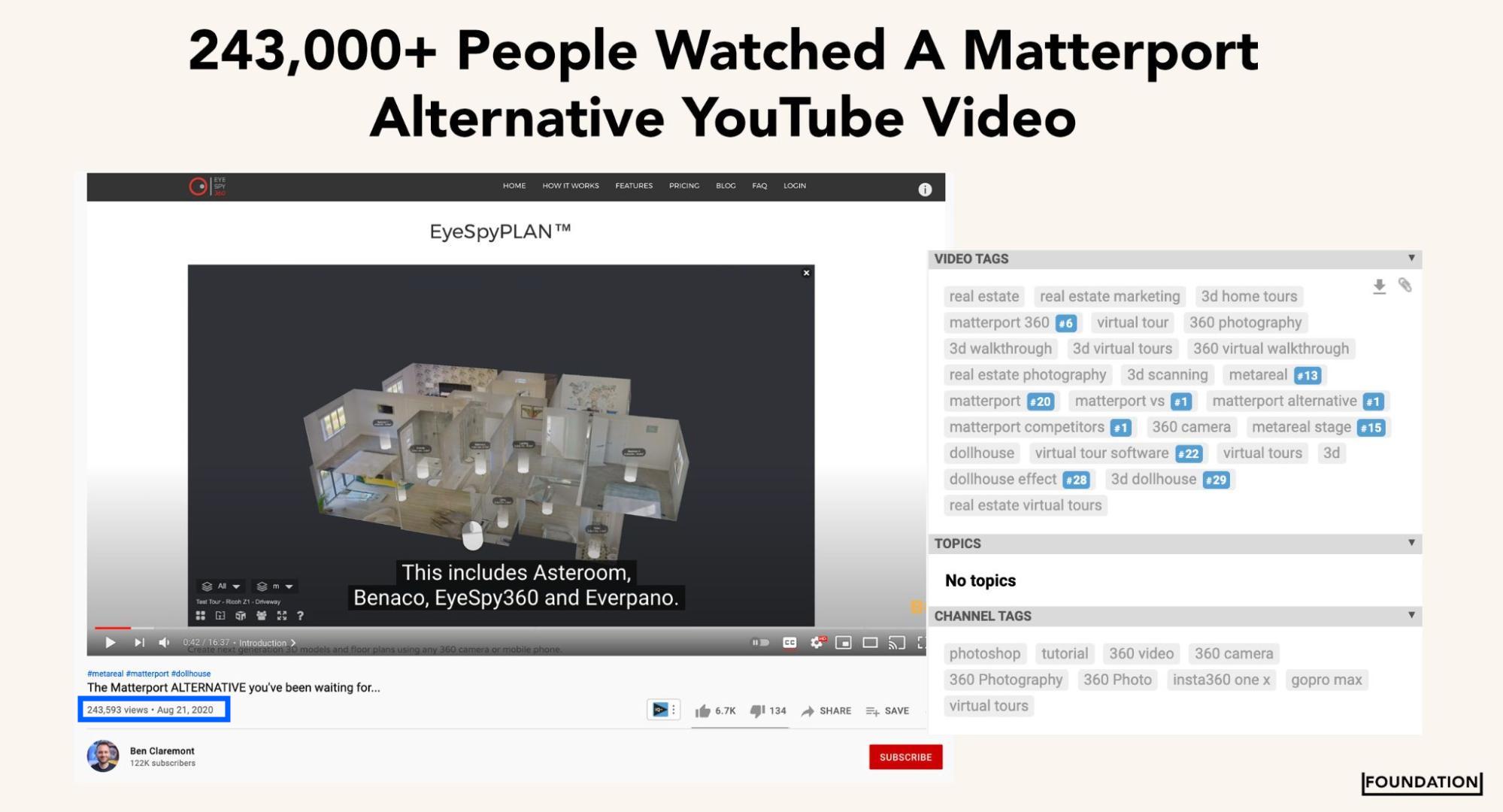
243,000 PEOPLE!
That’s massive.
In the chart on the right, I’m showing you the tags that are used on this video. These tags are used by Google to know what the video is about and added by the uploader as a part of the YouTube optimization process. You will notice that this video ranks #1 in YouTube for “Matterport vs”, “Matterport Competitors” and “Matterport Alternatives”. That’s a lot of value going to this video every single month. And the video is promoting a competitor’s product.
All of this value is being captured by an influencer who in 2020 created a video asset that outlines some cheaper alternatives to their product. I’ve talked in the past about how brands like Fiverr have leveraged YouTube influencers to drive results for their brand and this case study solidifies why it’s so important.
Your YouTube strategy contributes to your ability to dominate the SERP. It’s still being slept on by most marketers but the brands that start to make this investment today are going to be sitting back and watching their returns roll in for years to come. If you’re trying to build an SEO moat that is sustainable and will weather most storms — investing in both written and video content is the best way to increase your likelihood of unlocking success.
Quick, do it now before the next drop!








